
Fynbos is a small belt of natural shrubland or heathland vegetation located in the Western Cape and Eastern Cape provinces of South Africa. This area is predominantly coastal and mountainous, with a Mediterranean climate and rainy winters. The fynbos ecoregion is within the Mediterranean forests, woodlands, and scrub biome. In fields related to biogeography, fynbos is known for its exceptional degree of biodiversity and endemism, consisting of about 80% species of the Cape floral kingdom, where nearly 6,000 of them are endemic. This land continues to face severe human-caused threats, but due to the many economic uses of the fynbos, conservation efforts are being made to help restore it.

Xanthium (cocklebur) is a genus of flowering plants in the tribe Heliantheae within the family Asteraceae, native to the Americas and eastern Asia and some parts of south Asia.
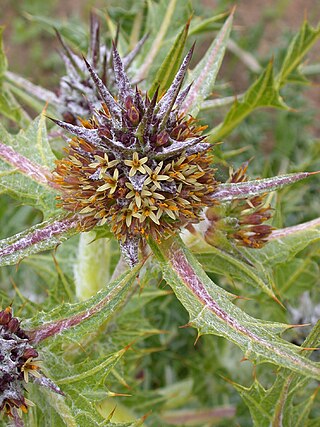
Gundelia or tumble thistle is a low to high (20–100 cm) thistle-like perennial herbaceous plant with latex, spiny compound inflorescences, reminiscent of teasles and eryngos, that contain cream, yellow, greenish, pink, purple or redish-purple disk florets. It is assigned to the family Asteraceae. Flowers can be found from February to May. The stems of this plant dry-out when the seeds are ripe and break free from the underground root, and are then blown away like a tumbleweed, thus spreading the seeds effectively over large areas with little standing vegetation. This plant is native to the eastern Mediterranean and the Middle-East. Opinions differ about the number of species in Gundelia. Sometimes the genus is regarded monotypic, Gundelia tournefortii being a species with a large variability, but other authors distinguish up to nine species, differing in floret color and pubescence. Young stems are cooked and eaten in the Middle-East and are said to taste like a combination of artichoke and asparagus.

Scolymus maculatus is a spiny annual plant in the family Asteraceae, native to the Mediterranean region in southern Europe, southwest Asia, and northern Africa, and also the Canary Islands. It has pinnately incised prickly leaves and prickly wings along the stems, both with a white marginal vein. The yellow flowerheads stand solitary or with a few together at the tip to the stems, and subtended by more than five leaflike bracts. The plant is known as scolyme taché in French, cardogna macchiata in Italian, cardo borriquero in Spanish, and escólimo-malhado in Portuguese, חוח עקוד in Hebrew and سنارية حولية in Arabic. In English it is called spotted golden thistle or spotted oyster thistle.

Gazania rigens, sometimes called treasure flower, is a species of flowering plant in the family Asteraceae, native to coastal areas of southern Africa. It is naturalised elsewhere and is widely cultivated as an ornamental plant.
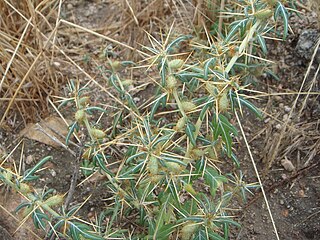
Xanthium spinosum is a species of flowering plant in the aster family known by many common names, including spiny cocklebur, prickly burweed and Bathurst burr. This species is part of the genus Xanthium that encompasses 25 different species of flowering plants of the daisy family, Asteraceae, and sunflower tribe.

Macledium is a genus of flowering plants in the family Asteraceae. Both Macledium and Dicoma are distributed largely in tropical and southern Africa. Macledium is distinguished from genus Dicoma by a large number of characters relating to morphology and anatomy of phyllaries, corolla, anthers, style, cypsela and testa.

Cadaba aphylla ("Swartstorm") is one of the many species in the genus Cadaba. It is indigenous to southern Africa.

Scolymus grandiflorus is a spiny annual or biennial plant in the family Asteraceae, native to the Mediterranean region. With up to 75 cm high stems, it is the smallest of the species of Scolymus. Its stems are lined with uninterrupted spiny wings. It also has the largest flowerheads in the genus, of approximately 5 cm wide. It has yellow, sometimes yolk-yellow ligulate florets. Its vernacular name in Maltese is xewk isfar kbir, meaning "large yellow fin", cardogna maggiore in Italian, scoddi on Sicily, and scolyme à grandes fleurs in French.
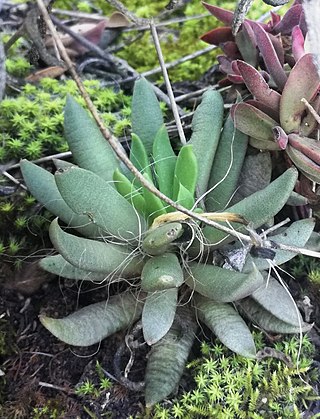
Anacampseros lanceolata is a species of succulent plant native to the western Karoo and Overberg regions of South Africa.
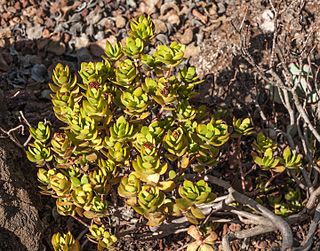
Crassula cultrata is a succulent plant native to the southern parts of South Africa.

Crassula subaphylla is a succulent plant belonging to the family Crassulaceae. It is widespread in the Karoo regions of South Africa and Namibia.

Crassula biplanata is a succulent plant native to rocky ledges and mountainous areas in the southern parts of South Africa.

Pteronia incana is a species of flowering plant in the family Asteraceae, indigenous to the Karoo regions of South Africa.
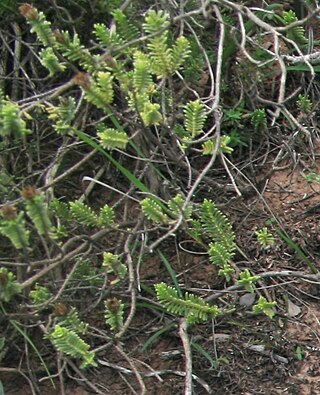
Oedera uniflora ("Kalksteenperdekaroo") is a prickly shrublet belonging to the family Asteraceae.
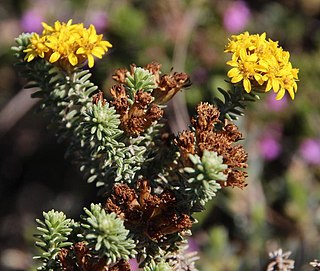
Relhania garnotii is a shrublet belonging to the daisy family, indigenous to the southern Overberg region of the Western Cape Province, South Africa.
Pteronia glauca ("Geelboegoekaroo") is a species of flowering plant in the family Asteraceae, indigenous to the Karoo regions of South Africa.
Pteronia oppositifolia is a species of flowering plant in the family Asteraceae, indigenous to the western Little Karoo and Overberg regions in the Cape Provinces of South Africa.

Euphorbia tuberosa, commonly known as '"milkball/melkbol"' or '"wilderamenas"', is a variable geophytic plant of the family Euphorbiaceae, indigenous to the western parts of South Africa.
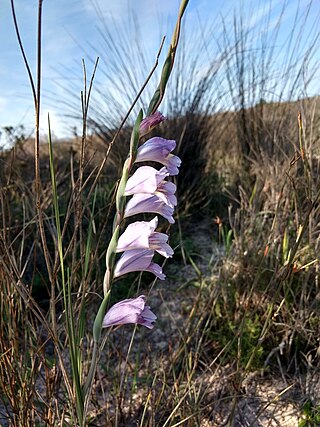
Gladiolus patersoniae is a herbaceous perennial plant belonging to the genus Gladiolus of the family Iridaceae, indigenous to the southern Cape regions of South Africa.



















